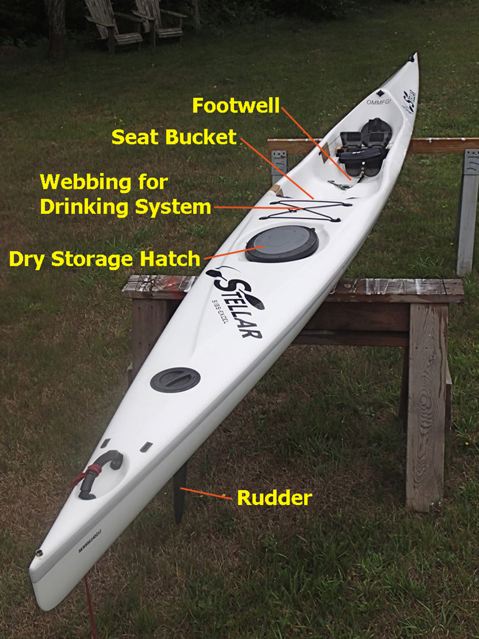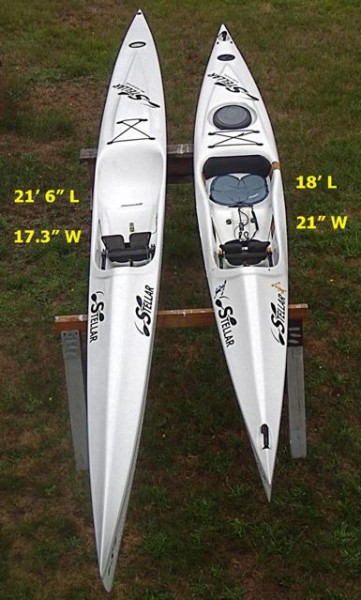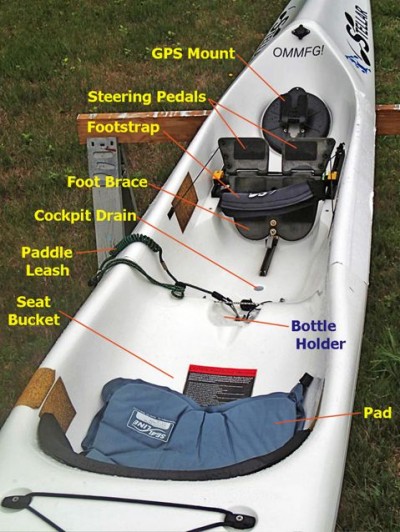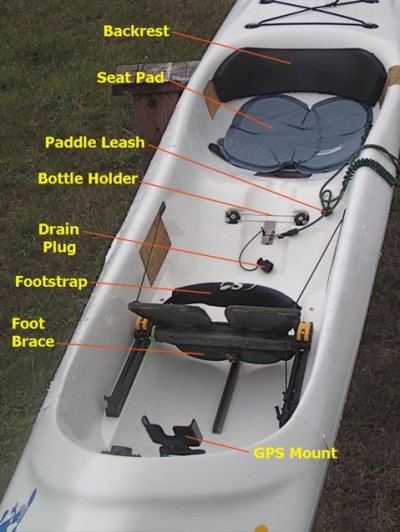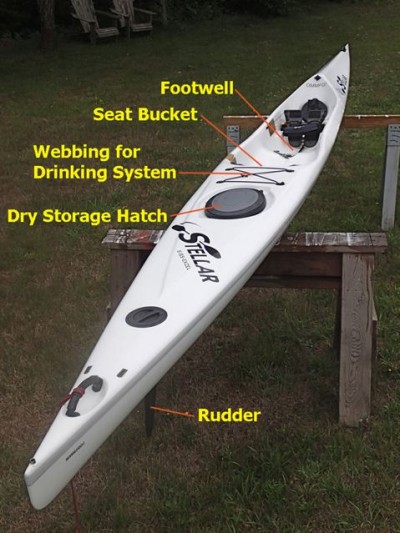August 6– Today I took it easy and just practiced remounts on my boat– the technique for getting back aboard if a capsize occurs. I’ll be doing the trip in my 18′ hybrid surfski, which differs from traditional kayaks in that the paddler sits in a recessed bucket in the deck– effectively on top of the boat, rather than secured in a cockpit with a spray skirt. Surfskis originated in Australia as a means for lifeguards to punch out through the surf line quickly; from those beginnings, they have evolved into the fastest human-propelled open-ocean boats in the world, and the sport of surfski paddling is booming globally. While I do own a pure racing ski as well, for the trip around the Vineyard I’m going with old faithful, my 18′ Stellar touring ski in which I did my first circumnavigation in 2012.
While not nearly as fast as longer skis at the top end, the 18′ boat is exceptionally stable and, at 28 lbs, cruises effortlessly at 5.5 mph for hours on end; I’ve based all my calculations on that base speed, then factored in wind and current assists where applicable. 10 hours and 52 miles is a long time to be on the water, and the tippier the ski, the greater the risk of “boat fatigue”, wherein the paddler must devote more and more focus and energy into keeping the boat upright as he/she gets tired, in addition to propelling it forward. My 18-footer, which is based on a standard fast sea kayak hull, inflicts minimal fatigue and delivers maximum comfort and confidence.
Attached are some photos of the seat bucket, deck and arrangements for essential equipment; furthest forward is the mount for the navigational GPS, affixed to the hatch for the bow storage compartment, then the foot brace with pedals to control the rudder, and aft of that the drain plug which serves to suction water out of the footwell as long as a certain forward speed is maintained (by their very nature, surfskis ship a lot of water in ocean conditions). Next comes the water bottle holder, and all-important paddle leash; my boat is so light that, were I to capsize in strong winds, it would drift away much faster than I could swim in pursuit…. but by leashing the paddle to the hull, the paddle in effect acts as a sea anchor to slow the drift down (in really big conditions, the pros affix leashes to their ankles too, just like surfers).
For the sake of long-duration comfort, I use a SeaLine seat pad which fits perfectly in the bucket and allows me to float on a cushion of air; while that would throw the balance off in a higher-performance ski, it has little effect on the stability of this boat, and is worth its weight in gold as far as eliminating pressure points and the attendant discomfort when seated for hours on end. Likewise, since my boat has a one-size-fits-all seat bucket, I cut and fit some minicell foam to form a custom backrest specific to my anatomy, which is equally beneficial on long trips.
Behind the seatwell is some deck webbing to which I affix the larger of my Camelback fluid reservoirs (the second goes in a pouch on the back of my PFD)…. this boat is tippy enough at rest– particularly on the open sea– that it’s more efficient to have drinking tubes clipped to the shoulders which are easy to grab and drink from while continuing to paddle; I’ll be alternating swigs of water and Gator Ade every 15 minutes. Further aft is the hatch for the rear storage compartment; this particular surfski is unique in that it can double as a weekend touring boat, with enough dry storage area for minimalist camping gear. For the trip around the Vineyard, I’ll carry a soft cooler with lunch, extra bottles of Gator Ade and water to refill my Camelbaks at the Cape Poge landfall, medical kit with insulin and glucose meter, as well as extra hat, headband and sunglasses beneath the aft hatch. Furthest aft is a small hatch to access the rudder post; I have two interchangeable rudders, a shallow 4″ for calm water paddling, and 8″ surf rudder for better control in ocean conditions. While the deeper rudder does create a little more drag and slow the boat down infinitesimally, I do plan on using it for the circumnavigation as I hope to have following seas for the final leg down Vineyard Sound, catch some surf towards the Finish!
